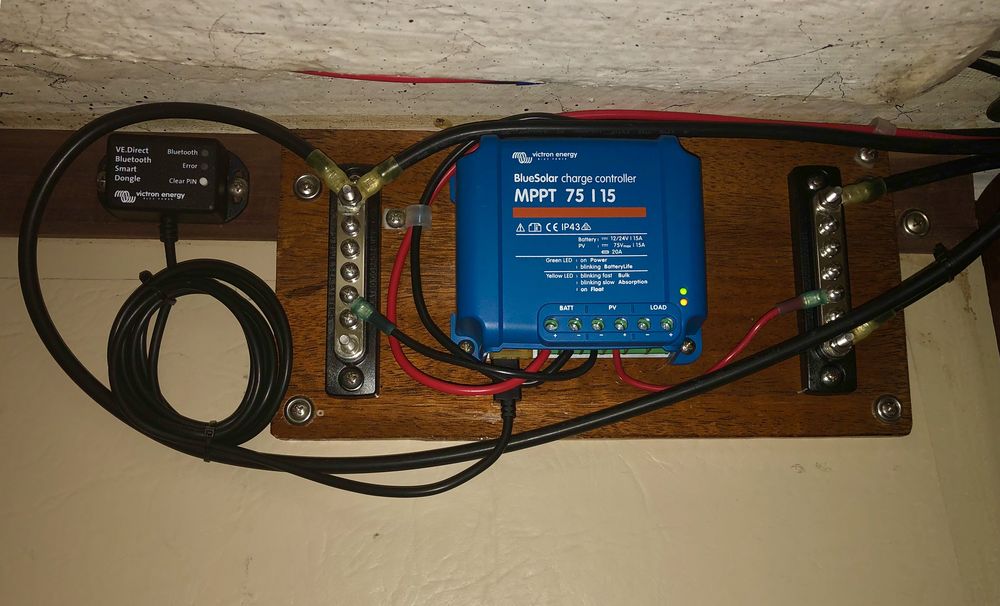I think the controller you use is at least as important as the solar panels.
I use a 50-watt panel and a Genasun charge controller. I spent more on the controller than on the panel.
I use an electric trolling motor instead of a gas outboard, so I'm reliant on electricity.
The 50-watt panel is more than enough when I'm day sailing three times a week.
It doesn't keep up when I'm camping out on the boat. Between playing music, charging phones, and running the lights at night I'm using just a little more than what the panel puts out. But I only stay on the boat for two days, so I have plenty of reserve battery, and after a couple days away from the boat the battery is back to full again.
If you want to be out for a week and plan on using a moderate amount of electricity you might want a 100-watt panel.
Sorry if this subject has been covered.
I'm looking for suggestion for keeping my 22 battery top off while on a week long sailing trip.I have to admit my total lack of understanding my electrical system or better yet what my batteries needed to charge it fully.
It seems a 12v AGM battery needs 10-15amps to keep it charge up. My 13w solar panel was only putting out 1.08a which wasn't doing anything. Now my 3+ year old battery is headed down and won't charge up to more than 12v .
I looked into what it would take to keep it charged up with a solar panel and it looks like at least a 150w panel =12.5a. The folding ones I see are pretty big for a 22.
So what is everyone else using
Thanks Roderick
First, don't confuse watts / amps from the panel (instantaneous) with watt-hours / amp-hours to or from a battery. The first is measured at a single point in time, the latter is a total amount of power delivered to a battery (or delivered by a battery to your electrical devices). I.e., you care about maximum power delivery _and_ about how many hours your panel can provide that power for. Your battery will be rated in amp-hours - e.g. a group-31 AGM might be 105 Ah. At 12.6v that's 12.6 * 105 ~= 1300 watt-hours. You don't want to drain a lead-acid battery below about 50%, so that's ~52 Ah / 650 wh of usable capacity (but measure conservatively, because battery capacity decreases over time, and you don't want to
Recommendation: First, try to compute your power budget. That sounds complicated, but it's really pretty easy - look up the power draw of the devices you run and estimate how many hours you'll be using each device for. Some are probably on 24/7 (e.g a battery monitor or a CO detector). Some will be on for only a few hours per day (VHF, cabin lights, perhaps).
Our power budget while cruising comes in at ~370 watt-hours (~30 amp-hours). That includes VHF (for 9 hours) cabin lights, charging phones, the 2 iPads that we use for navigation and/or entertainment, anchor light, etc. (I can share that spreadsheet if it'll be helpful).
To power that, we use 2 50-watt panels. I can't quite swing the great Solbian panels recommended by
@Maine Sail, so I use 2 cheap ones - if one breaks, I still have 1/2 my power for the rest of the cruise (and they're only ~$100 to replace). We use a Rogue 20A controller, which isn't available anymore. You might look at the Victron (
https://shop.marinehowto.com/products/victron-75-15-mppt-controller). I really like the remote display on my Rogue, but the Victron's price is very reasonable.
I've heard that a good rule of thumb is to estimate that you'll get ~5 hours per day of your panel's maximum power, spread over ~12 daylight hours. So a 50w panel might deliver ~250 watt-hours. In reality, it will be much less than 50w in the morning and evening, and only come close to peak output (if you're lucky) around mid-day. Here in the cloudy PNW, I estimate 3.5 hours.
I find that our solar system gets behind a little if we're out sailing for a few days straight - I usually only put the panels out when we have the bimini up, and the sails often shade the panels. We catch back up if and when we spend a day or two at a dock. As you'd expect, we also get behind on rainy days. So it's good to have enough battery and panel capacity to handle clouds or rain. We've gone out for up to 2 weeks at a time, and I don't think we've every drained our batteries by more than ~40 Amp-hours (~20%). We caught back up when the sun came out.
AGM's are pretty sensitive to charging voltages. So when you look for a charge controller, be sure to get one that you can configure to match the voltages your batteries expect (your battery manufacturer will have a manual for the battery listing all those voltages). I made the mistake of buying a standard controller, and then found I had to replace it with a more configurable model to avoid frying my AGMs.
Protip: Look at some of
@Maine Sail's articles over at his subforum, and at marinehowto.com. You'll learn more than you ever thought there was to know about batteries and solar.









